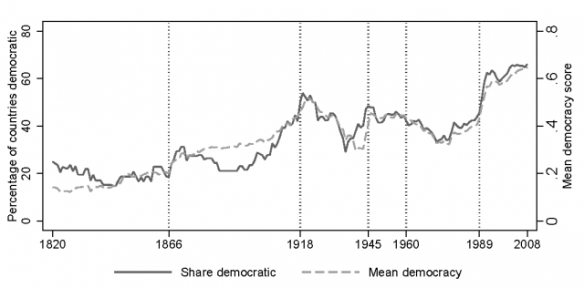The ‘Arab Spring’ demonstrated that political transitions tend to occur together in space and time.
Samuel Huntington coined the term ‘Waves of democratization’ in his book The Third Wave. The figure above shows that changes to the proportion of the world’s countries that are democracies occurs in spurts. Confirming Huntington’s three waves of democratization, spurts occurred from the 1890s up to 1920, from 1935 to 1945, and from 1975 up to today. There are also reverse waves — from 1920 to 1935 and from 1945 to about 1970.
Huntington demonstrated the waves empirically, and provided a number of explanations for why they occur. He did not offer a comprehensive statistical analysis of why such waves occur, however. This is what we do in a revised version of a paper entitled ‘Why Waves?’ that we recently posted here.

Forces external to countries are important to explain waves, such as steady economic growth occuring in many countries simultaneously, sudden global or regional economic crises, transitions in neighboring countries, or systemic shocks such as the World Wars or the end of the Cold War. Following up on our earlier work, however, we argue that explanations of democratic waves must also be seen in conjunction with the intrinsic internal stability of political systems. There are two main sources of such instability. First, political systems that combine democratic and non-democratic systems are rarely viable in the long run. Authority is not sufficiently diffuse to ensure that the democratic process is not subverted or challenged. Elites in such a system are tempted to garner more power for themselves and thereby compete with one another since the potential for enrichment are substantial. At the same time, non-elites are likely to have an interest in limiting the power of the political elites, and will pull in a democratic direction. In this way, institutionally inconsistent polities are not self-enforcing, in contrast to repressive dicatorships or consolidated democracies. Second, pressures for democratization tend to mount with increase education levels among citizens and more diversified economies. Middle-income autocracies tend to be less stable than low-income ones. Waves of democratization are particularly likely to break when external factors simultaneously impact multiple countries that are unstable in this manner.
Author: Håvard Hegre, PRIO researcher
This post was originally posted 9 January 2014 at Håvard Hegre’s private website.